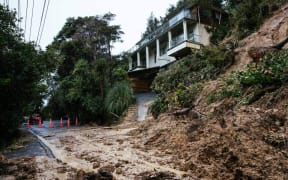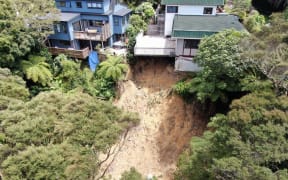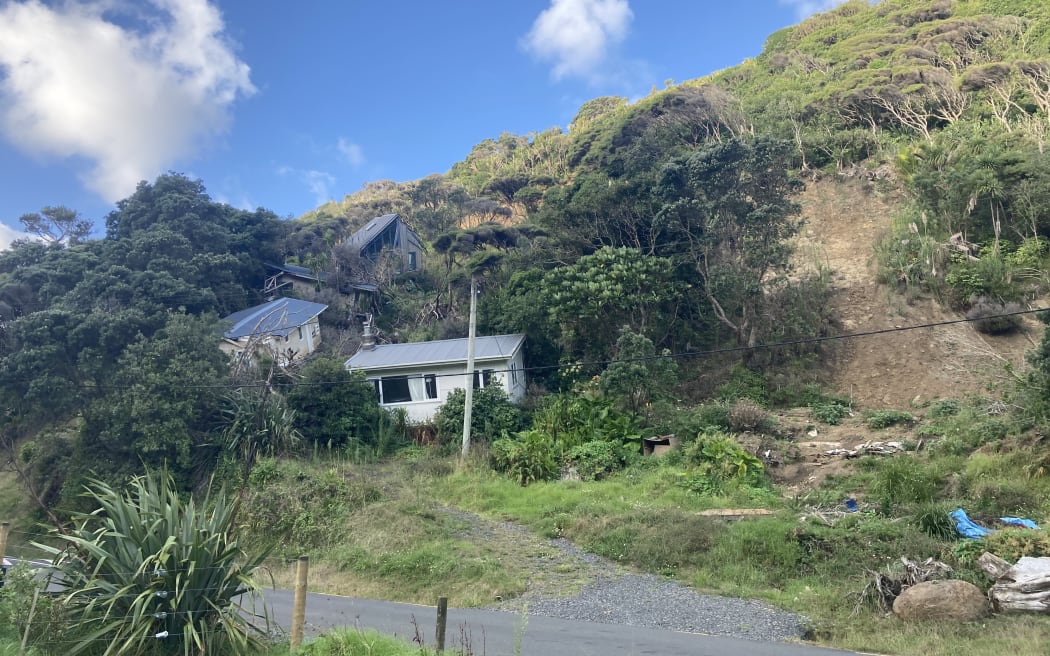
A red-stickered house in Karekare, Auckland. Photo: Leonard Powell
Emergency authorities are warning that Cyclone Gabrielle rates as only a "moderate" natural disaster, and that much worse lies ahead.
Yet the storm 14 months ago left the country's emergency response system in tatters, despite years of reviews and efforts to make laws and systems that deliver for people in harm's way.
The many inquiries since, such as the one released on Tuesday, are finding more gaps and adding to an already very long 'to-do' list, at a time when central government and council resources are short.
"While devastating to the communities involved, Cyclone Gabrielle can be considered as a moderate scale event when compared to what New Zealand could experience," the National Emergency Management Agency (NEMA) said in a briefing to the incoming minister last November.
"As seen with recent severe weather events, the emergency management system can be easily overwhelmed with a moderate scale event."
There are now at least 26 inquiries into how it was "easily overwhelmed", by cyclones Gabrielle and Hale, and by the Auckland Anniversary floods.
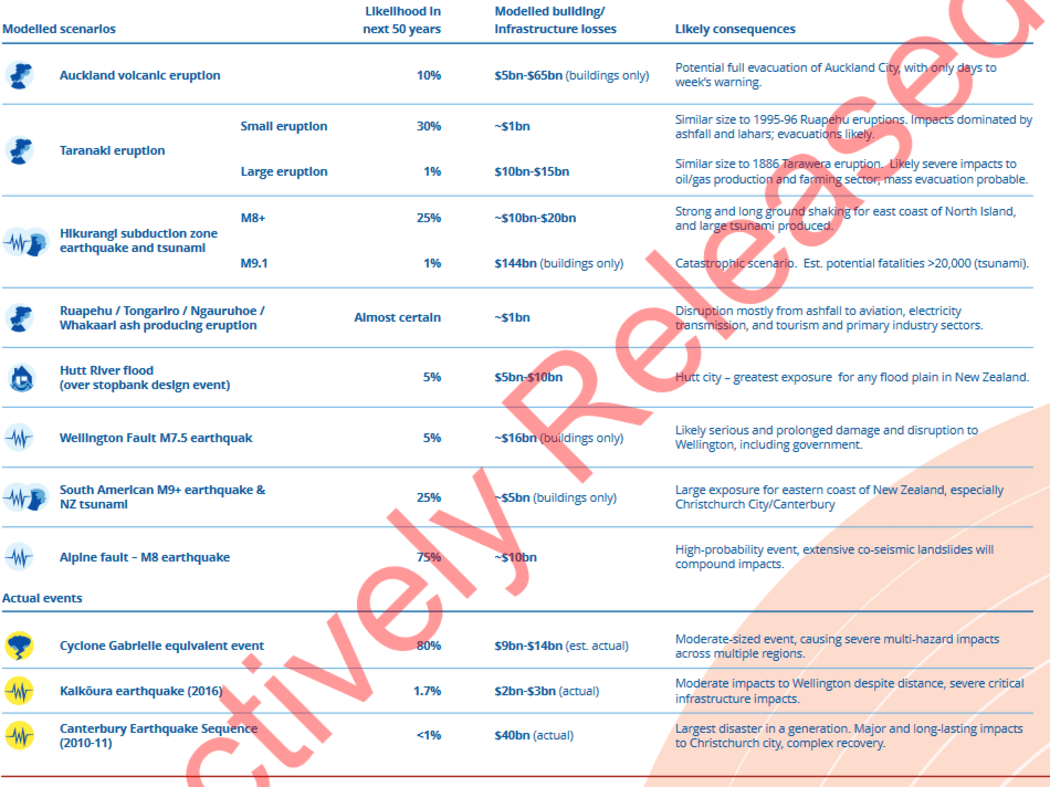
A list of natural disasters from the National Emergency Management Agency's briefing to the minister. Photo: NEMA
Most of these are by consultants working for Civil Defence and critical industries like telecoms. A glance through just 10 of the inquiries counts 600 pages of findings and advice, and more than 120 recommendations.
Many of them echo similar findings and advice from 2017, 2020 and other past reviews into emergency response shortcomings.
'We've run out of time'
To avoid another repeat, the biggest burden falls on Emergency Management Minister Mark Mitchell.
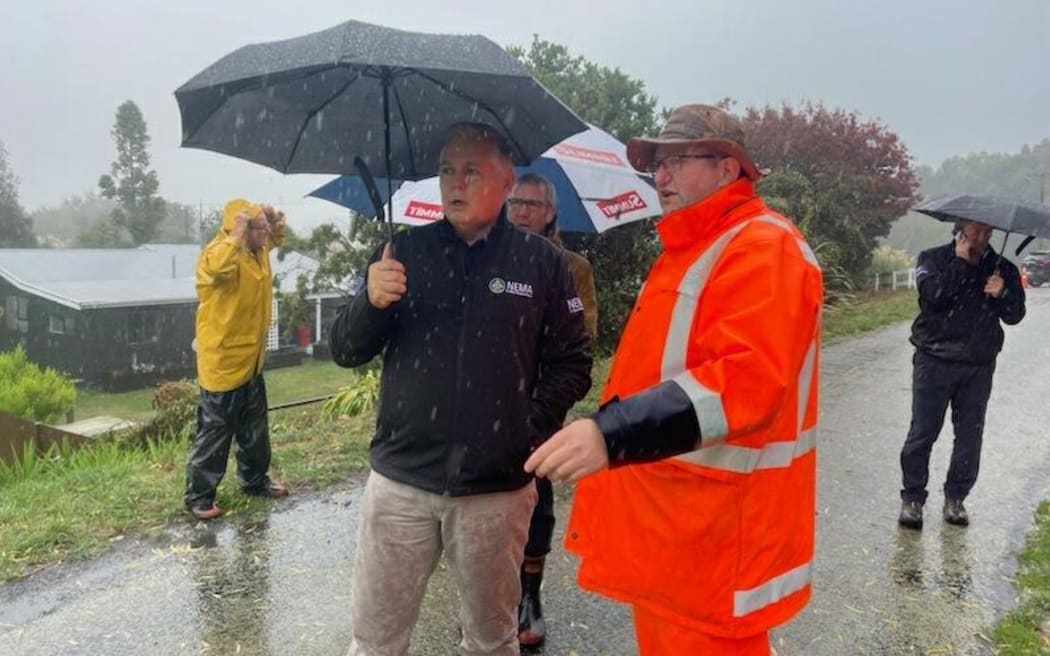
Mark Mitchell at the Spring Creek stopbank in Marlborough on 12 April 2024. Photo: Supplied / Marlborough District Council
He said on Tuesday he would consider all the reports and "make further decisions in the next few months".
You can compare what he went on to say on Tuesday, with what his predecessor, Labour's Kieran McAnulty, told RNZ last year about fixing the emergency response system:
McAnulty, June 2023: "It is important that we take the time needed to get this right".
Mitchell, April 2024: "I want to take the time to get this right".
Mitchell told Morning Report on Wednesday: "We've run out of time. We have to get this done and we're going to do that."
However, the country's track record is poor, it is going backwards in scrapping a law change that took years of work, resources are stretched, and vital technology is outdated or missing.
Inadequate, antiquated technology and intelligence infrastructure
The inquiry report released on Tuesday found three big technology holes: On the warning systems for local people; in how responders share a "common operating picture" of what is happening; and in the 111 system to call for help.
The holes have been known for years, but recommendations to fix them have been ditched.
Compare this with the 2017 ministerial review, another 2020 inquiry, and from this week:
2017: "New Zealand's intelligence infrastructure and hardware has been inadequate in recent emergencies, although agencies individually have a lot of capability to draw on. Recent advances in technology could help provide better intelligence... a new fit-for-purpose all-of-government... 24/7 monitoring, alerting, and warning centre is required.
"Further we recommend investigating existing technologies available internationally to support a common operating picture."
2020: A review of Napier floods called the lack of a common operating platform "a missing link" that caused "significant frustrations". It got its own two-page section in a 42-page report on how to fix this.
However, the new inquiry said it "understands that a business case [for a common operating picture] developed in 2019 was not progressed". RNZ has requested that business case.
It then repeated the recommendation from 2017 and 2020, saying otherwise that responders get "swamped":
2024: "We heard that NEMA made regular requests for information from regional and local CDEM... Without a common operating picture, information had to be repeatedly requested rather than being provided automatically. We heard these requests swamped many regional and local coordination centres, drew capacity from elsewhere and affected their ability to manage their crisis response... The inquiry strongly recommends the government invest in a common operating platform."
The second hole is less obvious. The country does have a shared warning system, that has been routinely upgraded, where smartphones get pinged with alerts. But a lot of people told the latest inquiry they did not get alerted, and the report said:
2024: "A comprehensive warning system is needed that is flexible enough to cover most, if not all, natural hazards."
What would that involve? Multi-millions, Telecommunications Forum chief executive Paul Brislen said.
And it would require satellites and short-range radio in addition to cellphones and landlines.
Matthew Nolan, who championed a rival system that was in use several years ago, said the current system could not tell officials if people had got the warning they sent out, and could not target small groups of people well enough.
Does the country have the best warning technology? That joins the to-do list.
The inquiry recommends "manual" warning options too, for when the power goes out and the batteries fail.
There is also a non-tech solution that is a central theme of the inquiry, where it urges the government to legislate to give community groups and iwi - who can see what is going on, and warn neighbours, and alert councils - more say, and more sway, over how civil defence runs in their area, as was reported on Nine to Noon on Tuesday.
The third tech hole is the antiquated 111 system.
But the inquiry's recommendation on that, for a "comprehensive review", is out of date. Report after report has already found the 111 tech is old, slow and fragmented - the most graphic of which a year ago, from police, gave examples to the previous government of how it was causing deaths and injuries.
Lawmakers were just about to hit the button on replacing the 111 (or CARD) system last year when they pulled back because of the cost.
They chose instead, to upgrade just one part of emergency communications, the Public Safety Network (an ongoing build now itself suffering delays), rather than this and CARD.
Two months ago Prime Minister Christopher Luxon said, "I know the minister's all over it", regarding 111's problems.
Mitchell told Midday Report on Tuesday the 111 system could be fixed by "regulation" or "operational orders" or by changing "the systems". RNZ has asked him to clarify the first two options, as the various reports into 111 say the tech must be replaced.
Later, on Wednesday on Morning Report, Mitchell said the tech fixes would have to wait till the law was changed.
"Everything flows from the legislation. It codifies and clearly explains command and control responsibilities," he said.
"That's the building block, we've got to have a solid platform."
Mitchell cited progress.
On Tuesday he said emergency responses worked well this year at the Westland floods and the Christchurch Port Hills fire.
However, these were small-scale, not "moderate" events, and the fire was a repeat scenario, while the West Coast is not representative of much larger, less cohesive communities, and how they respond to a disaster.
Resource shortfalls
New South Wales had its own long to-do list after extreme floods two years ago. Quickly, the state government put more than $200 million into new rescue boats, high-clearance trucks and 2300 more trained rescuers.
In New Zealand, the 2017 review looked across the Tasman for lessons: "We looked for best practice in the emergency management systems of other jurisdictions - Australia, United Kingdom, United States and Canada".
This week's inquiry did not do that.
Mitchell, asked by RNZ on Wednesday, how the government could afford the to-do list, said:
"Yes, we've got arcane infrastructure that needs investment and we committed to doing that, but we have to do that in a measured and a well-planned way because obviously we're in a position at the moment as a country where we've been living well beyond our means."
The minister was told in November 2023's briefing from NEMA: "In some cases, there may not be the capacity to fully respond to and recover from a moderate or even small-scale event".
Additionally, it was "very likely we will experience two or more concurrent major events. This will lead to long and overlapping recoveries".
Mitchell has put changing emergency law, and changing NEMA at the centre of the big fix.
NEMA's lack of mandate and muscle comes out again and again.
It had a $900,000 fund to support local and regional readiness capability and practices, the new inquiry noted. "This fund has remained at a similar level since it was established in the 1990s."
2017: "It will be important that NEMA has the resources and capability to credibly do the job expected of it. We expect that will require strengthening of the capability and capacity".
2024: "The role of NEMA needs reassessment. It is a small agency that does not have the funding or expertise to undertake the full breadth of activities it is currently tasked with".
NEMA's latest annual review lists a series of delayed projects, and shows that while $130m was budgeted for a large range of emergency management support funding it managed to spend only about $80m of that (with $30m carried forward to this year).
The agency runs on $39m a year, and is part of the Department of Prime Minister and Cabinet which must find 6.5 percent savings under the government-ordered public sector cost-cutting moves.
NEMA did not set up its Cyclone Recovery Unit till late in the financial year, so underspent by $1.2m out of a $2.9m budget.
Fire and Emergency by contrast with NEMA, has a $700m-plus budget.
But its review last week found it lacked the equipment, training, and preparedness in the face of Gabrielle and the Auckland floods. FENZ suggested it might bring in fixes - though its review is full of roundabout language and uses "may" a lot.
Having admitted it struggled with getting a common operating picture during the storms, what it termed "gaining the situational awareness", FENZ went on to say in its internal review that it "could consider whether improvements are needed to its communications systems".
RNZ reported on firefighters trying and failing to hire utes as Gabrielle loomed. FENZ did not mention this, but in its report said it had "an opportunity to revisit its business as usual, specialist response and surge capacity models to ensure it has suitable resourcing for large incidents and/or long duration events".
FENZ told RNZ last week it was still in the process of getting more vehicles.
It shares the broken 111 system with police (ambulance is linked but separate). Its annual review said replacing it had been shelved: "The project is likely to resume to maintain current system."
FENZ said it was expecting and planning for a lot more and worse storms, despite the inquiry finding its local planning was lacking.
However, Internal Affairs Minister Brooke van Velden has said she was "not convinced" FENZ needed more money (it wants to raise the levy on insurance premiums in July).
"I am seeking a commitment [from FENZ] ... to cost savings where appropriate to keep levies affordable," she said.
Aside from central government, cash-strapped councils have little room to move on civil defence spending, especially when those in flood plains like Napier, Lower Hutt, face big stopbank upgrades.
Law to-and-fro
The 2017 review called for: "Strengthening the application of current legislation, consistent with the intent of the CDEM Act, together with some changes to allow stronger national-level direction and regulation".
In 2024, the country was going backwards, to go forwards, the government argued.
One bill has been ditched, another is still in play, and critical infrastructure that could reduce the damage from disasters continues to be very vulnerable.
The NEMA briefing to Mitchell in November said: "The relative vulnerability of people, property and infrastructure is growing".
It took the previous government six years from 2017 to get a bill ready, that it said reflected the experience of going through disasters.
It was due to be table in Parliament the week Gabrielle hit. It never landed, and now the new government has scrapped the bill, saying it did not go far enough.
RNZ reported a year ago that MBIE was resisting the law changes as "flawed".
The dumped bill purported to help "ensure that some of the most consequential gaps in our regulatory settings" were filled, but was much more about the aftermath of disaster, than the preparation beforehand. It did not empower the government to set new minimum standards for essential infrastructure.
A second piece of legislation is still alive. It revolves around what the industry must do to improve resilience.
It is early days, however.
The telecommunications industry had its first joint meeting on this last week - to plan for further meetings. The industry had opposed parts of the other dumped bill, for requiring unachievable assessments of their systems in the face of any disaster that might hit.
The legislative reset might put the two bills on the same track, a relief to telcos.
The upcoming Budget in May will indicate what the government's priorities are, beyond changing the law.
Mitchell has a big case to make to Finance Minister Nicola Willis. He has yet another inquiry this week to draw on to make the case.
Examples of the 26 inquiries into the North Island storms (several others have not reported back yet):
- Auckland Transport - 29 pages, six recommendations
- Auckland Council - 107 pages, 17 recommendations
- Auckland Civil Defence (CD) - 59 pages, 28 recommendations
- Bay of Plenty CD - 35 pages, 19 recommendations
- Wairarapa CD - 47 pages ,37 recommendations
- Hawke's Bay CD - 117 pages, nine recommendations
- Ombudsman - 34 pages
- Electricity lines network - 45 pages
- Telecoms forum - 15 pages
- Te Whatu Ora - 36 pages
- Northland CDE - 60 pages
- Environment Ministry - 34 pages

